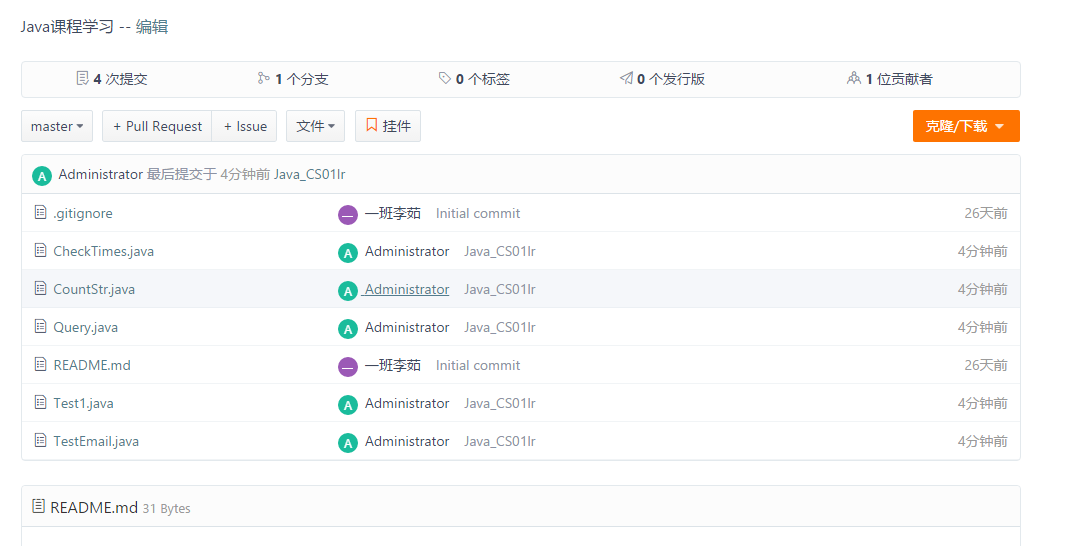(一)学习总结
1、构造方法用于在创建对象时对其进行初始化Person p=new Person
他的特点:(1)方法名与类名相同(2)方法名前没有返回值类的声明,方法中不能使用return语句返回一个值(3)用户不能直接调用,而是通过关键字new自动调用
方法的重载就是方法名称相同,但参数的类型和参数的个数不同,通过传递参数的个数及类型不同以完成不同功能的方法调用。
public class Test {
public static void main(String args[]) {
Foo obj = new Foo();
}
}
class Foo{
int value;
public Foo(int intValue){
value = intValue;
}
}不可以,类中没有定义无参的构造方法
2、编译没有错误,在运行时出错
public class Test {
public static void main(String[] args) {
MyClass[] arr=new MyClass[3];
arr[1].setValue(100);
}
}
class MyClass{
public int value=1;
public MyClass(){
}
public MyClass(int value){
this.value=value;
}
public int getValue(){
return value;
}
public void setValue(int value){
this.value=value;
}
}3、
public class Test {
public static void main(String[] args) {
Foo obj1 = new Foo();
Foo obj2 = new Foo();
System.out.println(obj1 == obj2);
}
}
class Foo{
int value = 100;
}运行结果为false ==比较的是地址,应该用equals方法
4、
class CashCard {
String number;
int balance;
int bonus;
public CashCard(String number,int balance,int bonus){
number = number;
balance = balance;
bonus = bonus;
}
}
public class Test {
public static void main(String[] args) {
CashCard card1 = new CashCard("A001",500,0);
CashCard card2 = new CashCard("A002",300,0);
CashCard card3 = new CashCard("A003",1000,1);
}
}封装把对象的所有组成部分(数据和方法)封装在一起构成类,对象本身的数据的得到保护/隐藏,其他对象通过该对象的访问方法(接口/interface)与之发生联系,好处:模块化,信息隐藏—通常定义一个公共接口/方法实现对对象的访问
5、(1)
class A{
private int secret = 5;
}
public class Test{
public static void main(String args[]){
A a = new A();
System.out.println(a.secret++);
}
}不能通过编译,在类中没有定义secret的getter和setter方法
(2)
public class Test{
int x = 50;
static int y = 200;
public static void method(){
System.out.println(x+y);
}
public static void main(String args[]){
Test.method();
}
}不能通过编译,因为x不是静态变量
6、使用类的静态变量和构造方法,可以跟踪某个类创建的对象个数。声明一个图书类,数据成员为编号,书名,书价,并拥有静态数据成员册数记录图书的总数。图书编号从1000开始,每产生一个对象,则编号自动递增(利用静态变量和构造方法实现)。
class Book{
int bookId;
String bookName;
double price;
String str;
static int num;
static{
num=1000;
}
Book(){
}
Book(String bookName,double price){
this.bookName=bookName;
this.price=price;
num++;
}
public String getBookName() {
return bookName;
}
public void setBookName(String bookName) {
this.bookName = bookName;
}
public double getPrice() {
return price;
}
public void setPrice(double price) {
this.price = price;
}
public static int totalBook(){
return num-1000;
}
public void tostring(){
System.out.println("书名:"+bookName+" 书价:"+price);
}
}
public class Test{
public static void main(String args[]){
Book[] books = {new Book("c语言程序设计",29.3),
new Book("数据库原理",30),
new Book("Java学习笔记",68)};
System.out.println("图书总数为:"+ Book.totalBook());
for(Book book:books){
book.tostring();
}
}
}7、
在设计一个类时,需要保证在整个程序运行期间针对该类只存在一个实例对象,构造方法私有化,在类内创建一个实例对象,用私有静态成员instance引用该对象,定义静态方法getInstance()返回实例对象instance
class Sun{
private static Sun instance = new Sun() ;
private Sun(){ }
public static Sun getInstance(){
return instance ;
}
}
public class Test{
public static void main(String args[]){
Sun s1 = Sun.getInstance() ;
Sun s2 = Sun.getInstance() ;
System.out.println(s1==s2);
}
}8、
public class Test {
String str = new String("你好 ");
char[] ch = { 'w','o','l','l','d' };
public static void main(String args[]) {
Test test = new Test();
test.change(test.str, test.ch);
System.out.print(test.str);
System.out.print(test.ch);
}
public void change(String str, char ch[]) {
str = "hello";
ch[0] = 'W';
}
}运行结果为:你好Wolld
(二)实验总结
1.用面向对象思想完成评分系统
程序设计思路:
设计一个选手类,一个测试类,一个平分类写出他们的构造方法以及getter和setter方法,构造方法(有参和无参),在评分类中计算平均分,在测试类中进行验证
问题以及解决方案:
(1)、开始没有写无参构造方法,在调用时出错
(2)、注意","和“.”的使用,在编写程序时注意不要打错
(3)、输入的评委人数一定要大于三否则去掉最高和最低没有成绩
(4)、注意循环的使用以及嵌套,不要重复输入没有必要的信息
2.Email验证
程序设计思路:
可以设计4个方法分别测试email的地址是否合法,注意@和。同时存在,可用查询如果没有返回-1,查看是否同时存在,对于@在。之前可以检测他们的下标的大小,对于不能以@开头可以看看下表为0的是否为@,对com或cn或net或gov或edu或org结尾的可以提取字符串的后三个字符进行比较,在主方法中判断他们是否都正确
问题以及解决方案:
(1)、对cn的测试可以用。cn
(2)、注意字符串方法的调用为str.indexOf();
(3)、可以使用Boolean类型的返回值,在主方法中进行验证
3.查找子串
程序设计思路:
定义一个方法找到字符串中有几个子串,返回子串的个数,主方法中输出,在while循环中调用indexof方法,注意从方法返回的下标继续查找
问题以及解决方案:
(1)、注意是从indexof方法返回的下标开始第二次的查询,以后同理
(2)、注意当返回的下标不为一时,子串个数加一
4.统计文件
程序设计思路:
可以编写一个方法查找有多少个文件类型一个数,且进行文件首字母大写输出,先用split方法对字符串进行分离,再用substring进行文件第一个字母分离,大写输出,在定义字符串数组按“.”分离字符串,把字符串数组的最后一个字符串放到一个新的字符串数组中,计算文件类型以及个数
问题以及解决方案:
(1)、在对文件的首字母大写输出是可以用str.substring(0,1).toUpperCase()
(2)、在计数文件的个数时注意数组不要越界
(3)、在进行文件类型的统计要考虑到以a。txt为文件名的情况
5.类的设计
程序设计思路:
设计一个日期类,一个职工类,一个部门类,分别写出他们的getter,setterfangfa以及含参和不含参的构造方法,日期类可以调用str。replaceAll(",","-")方法,在测试类中调用getter和setter方法对职工的生日和参加工作时间进行设置,在测试类中进行信息的设置,实现查询
问题以及解决方案:
(1)、在设置日期类时可以调用replaceAll()方法
(2)、在改变员工的日期类形时,要调用getter和setter方法
(3)、可以对信息进行初始化在查询
(4)、可以设置一个Boolean类型的变量,如果不想继续查询可以终止查询






















 630
630











 被折叠的 条评论
为什么被折叠?
被折叠的 条评论
为什么被折叠?








